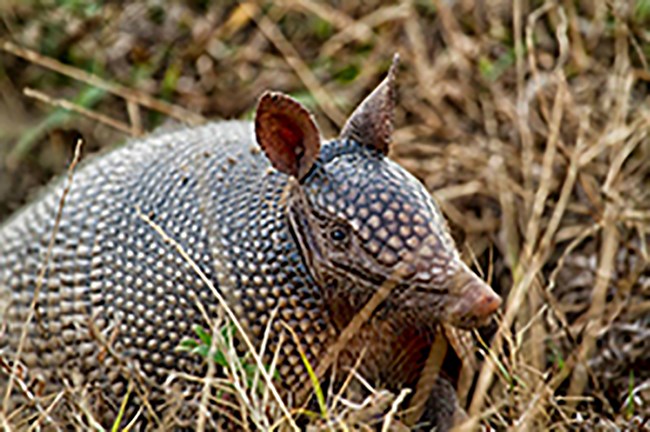
NPS Nine-banded Armadillo (aka: Little Armored One)Article by Deb Sanden, Volunteer
BackgroundThe nine-banded armadillo is the most underappreciated of the armadillos. Its ancestors originated in South America. They migrated to North America via the Isthmus of Panama, through Central America and Mexico, and crossed the Rio Grande River in the late 1800s. They were also introduced to Florida by humans during the same time period. HabitatsThey are found in many habitats, from rain forests and grasslands to dry scrublands and barrier islands. They cannot thrive in particularly cold or dry environments. Typically, their burrows are 8 inches wide, 7 feet deep, and 25 feet long. They mark their territory with feces, urine, and excretions from scent glands that are found on their eyelids, nose, and feet. They prefer to borrow in areas with ample coverage, near water sources, and open land.Physical AppearanceThe nine-banded armadillo, the only armadillo in the United States, is a medium-sized mammal. They usually weigh 5.5 to 14 pounds. Their total length, including head, body, and tail, is 25 to 42 inches. The outer shell is boney dermal ridges covered by overlapping keratinized scales connected by flexible bands of skin. The “armor” covers the back, sides of the head, tail, and outer surfaces of the legs. The other surfaces have tough skin and coarse hair. A plate (or carapace) covers the throat and upper back.The armadillos have tiny mouths and small peg teeth that look similar to molars except without enamel. Being avid diggers, the middle claw of the forefeet is elongated for digging.DietArmadillos are insectivores, and their main diet is ants, termites, grubs, beetles, and worms. Their sensitive nose can detect food through eight inches of soil.They have sticky tongues that lap up their prey. They have been seen rolling about in anthills to dislodge and eat the ants. Armadillos have even been known to dig up yellow-jacket nests!Additions to their diet include small amphibians and reptiles. Occasionally they eat bird eggs and baby mammals. They are attracted to carrion primarily to eat maggots.BehaviorArmadillos are solitary mammals that are primarily nocturnal. They usually forage between dusk and dawn. If panicked or frightened, armadillos can jump 3-4 feet straight in the air, and contrary to popular belief, they cannot roll into a ball for self-defense.A unique ability that armadillos have is the inflation of their intestines, which allows them to swim and walk along the bottom of a body of water. They can hold their breath for up to 6 minutes. This trait allows the armadillo to put its snout into the dirt for extended periods to forage.ReproductionArmadillos have a high production rate, and females always deliver quadruplets. At birth, each of the four offspring is nearly identical and same-sex.Predators and Disease RisksThe main predators are humans. They are eaten in many areas of Central and South America. There are many diseases associated with armadillos. They carry a mycobacterium known to cause leprosy and transmit this bacterium when they attack using their claws. They also have been known to carry rabies but rarely bite, so the disease is rarely transmitted.References
|
Last updated: March 1, 2021
